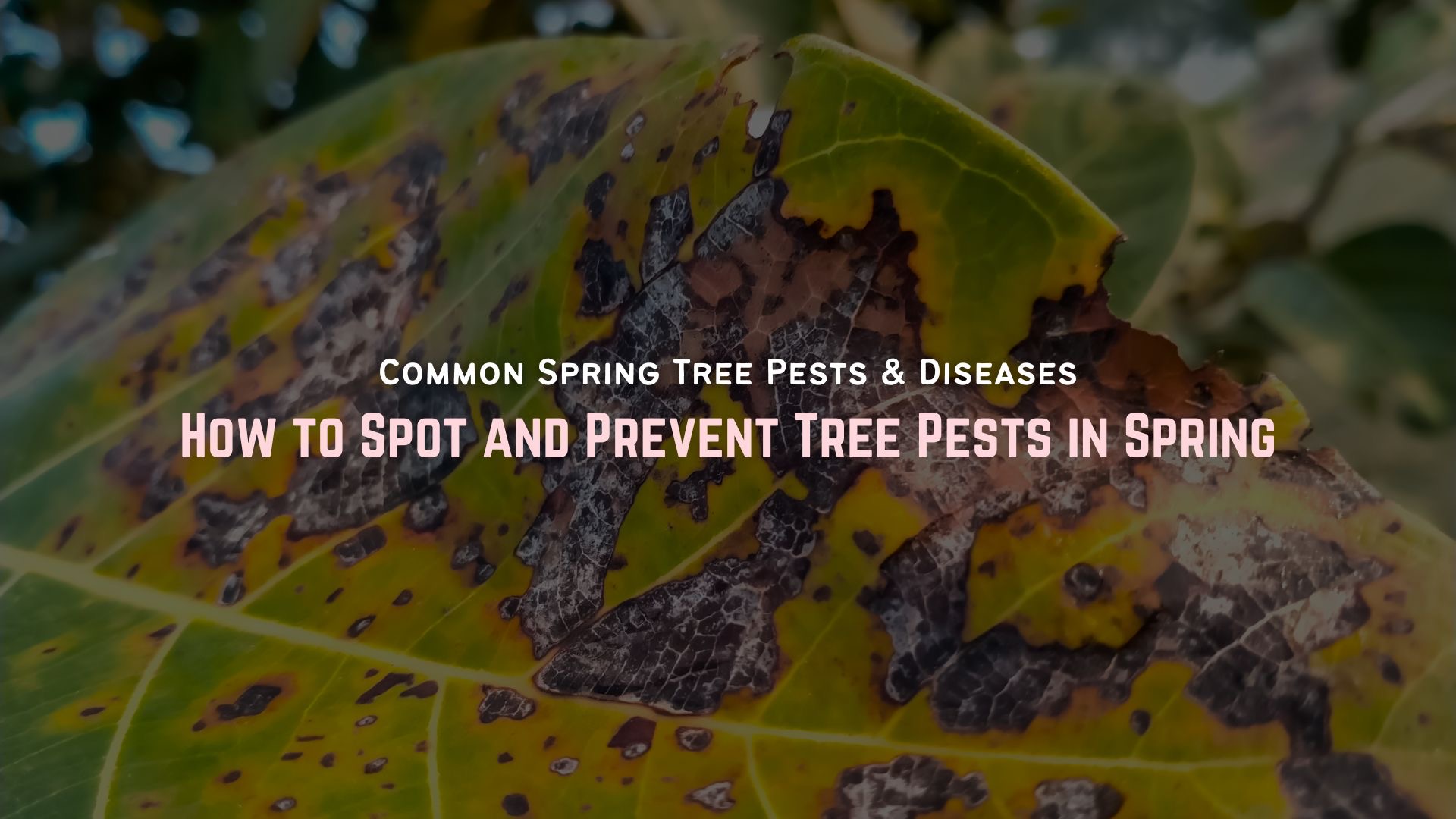Common Spring Tree Pests & Diseases: How to Spot and Prevent Them | Tree Pests to Watch Out For in Spring
If you’re dying to find out about common spring tree pests and diseases then About Trees can answer that!
The weather is warming up, trees are coming back to life, and your garden is starting to look a little bit like itself again. Time to rejoice! But also – time to be careful! Your trees can be particularly vulnerable to pests and diseases at this time of year, so it’s important to know how to take action to spot and prevent them. Let’s take a deep dive.
With the weather already beginning to change, it’s likely that you’ve already noticed your trees coming into their natural springtime fullness. But pests and diseases are also coming into their fullness, and they can threaten the health of everything growing in your garden.
Early detection and prevention are absolutely key when it comes to protecting your tree from the damage posed by pests and diseases. So, in this handy guide, we’ll take a look at the most common spring tree P&Ds, as well as how you can prevent them from infesting.
Why Spring Time is Critical for Tree Health
Spring time is the season for growth and abundance, but alongside opportunity – spring comes with plenty of risks. The season’s mild temperatures and increased moisture create the perfect conditions for pests and fungal diseases to thrive. In particular, young leaves, tender shoots, and fresh sap attract insects, while damp weather encourages fungal growth.
All of this means that, without proper care, infestations can weaken trees, stunt their spring growth, and even lead to long-term damage or death.
With this in mind, it’s important to recognise the early warning signs, so that you can prevent problems with your trees or take action to stop those problems from occurring.
Common Spring Tree Pests & How to Identify Them
1. Aphids
What are they? A small, green-yellow sap-sucking insect.
What signs of infestation should I look out for? Clusters of small, soft-bodied insects on new growth. Sticky residue on leaves (leading to soot-like mould). Curling or yellowing leaves.
How do I prevent aphids or treat an infested tree? Spray with a strong jet of water to dislodge them. Use insecticidal soap or neem oil (for severe cases). If possible, encourage natural aphid predators like ladybirds and lacewings.
2. Caterpillars (Including Winter Moth and Oak Processionary Moth)
What are they? With wormlike soft-bodied insects, caterpillars are the larval stage of butterflies and moths. (There are many different types, but for the purposes of this article, we’ll be talking about two common ones; Winter Moth and Oak Processionary Moth).
What signs of infestation should I look out for? Chewed or skeletonised leaves. Visibility (Meaning that you may be able to see some of them on your trees).
How do I prevent caterpillars or treat an infested tree? Remove caterpillar nests manually (wear protective gear for hairy caterpillars).
3. Vine Weevils
What are they? Black-brown beetles with broad snouts.
What signs of infestation should I look out for? ‘Notched’ leaf edges (vine weevils feed at night, so you might notice this in the morning). Wilting or sudden collapse of young plants (this happens because larvae eat roots).
How do I prevent vine weevils or treat an infested tree? Physically remove adult vine weevils at night (with a torch). Use nematodes (a species of roundworms) to target larvae.
NB: This is not an exhaustive list of the types of pests you might encounter. If you are uncertain, it is best to consult a tree care expert in your local area!
Common Spring Tree Diseases & How to Identify Them
1. Powdery Mildew
What is it? A common fungal disease that causes powdery dust to form on trees – most commonly on leaves.
What signs should I look out for? White, powdery coating on leaves. Distorted or stunted growth – particularly new growth.
How do I prevent powdery mildew or treat an infested tree? Prune overcrowded branches; this ensures adequate air circulation. Apply fungicides early. If you’re still at the early stage of selecting trees for your garden, consider choosing resistant tree varieties (the exact type of resistant trees will depend on your area).
2. Apple Scab (Affects Crabapples & Ornamental Apples)
What is it? A fungal disease that causes legions on the fruit of apple trees.
What signs should I look out for? Olive-green spots on leaves that turn black. Cracked, deformed, or lesioned fruit.
How do I prevent apple scab or treat an infested tree? Rake and dispose of fallen leaves to reduce spores. In early spring, apply fungicides before symptoms appear; this is a great preventative measure.
3. Fire Blight (Affects Rosaceae Family – Apples, Pears, Hawthorns)
What is fire blight? A bacterial disease that causes wilting.
What signs should I look out for? Brown, wilted leaves (these leaves will look “scorched.”) Sticky ooze from infected branches.
How do I prevent fire blight or treat an infested tree? Prune infected branches 12 inches below the damage. Avoid the application of high-nitrogen fertilisers, even those that promote succulent growth.
Last Thoughts: When in doubt, Call a Professional
The best advice we can give is that if you notice an infestation or disease spreading rapidly – or if you’re unsure how to treat something happening in your garden – you should consult a certified arborist or tree care specialist like us!
Some pests (such as Oak Processionary Moth) require professional handling due to health risks. Don’t take any chances – and, importantly, take care of yourself!


